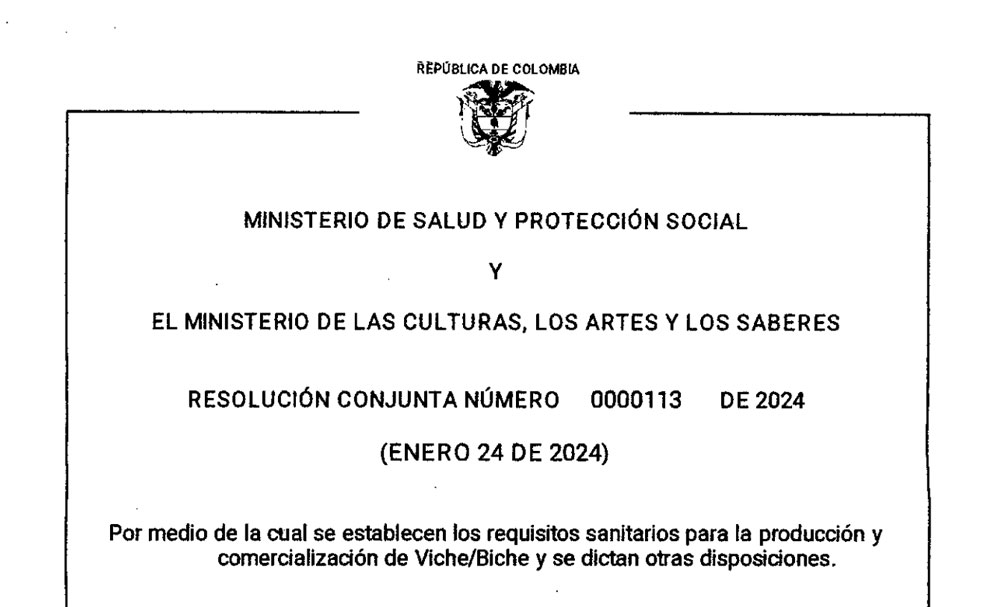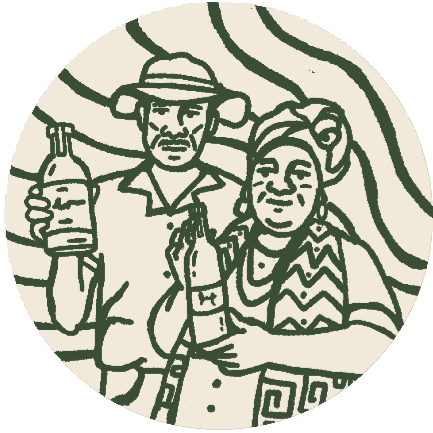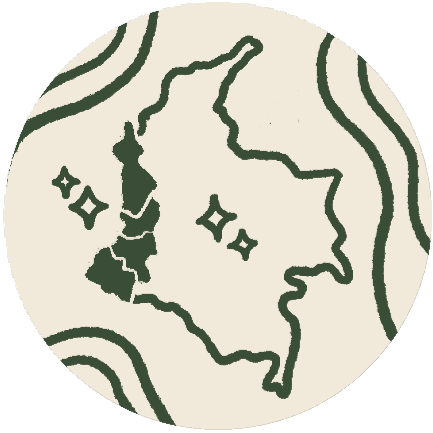JANUARY 24, 2024 UPDATE
The regulation has been released, recognizing the cultural, ancestral, and economic wealth of Viche for the Pacific territories, allowing producers to begin the path of commercialization Read here the resolution!

JANUARY 11TH · ANALYSIS OF THE VICHE RESOLUTION DRAFT
This document aims to analyze the content of the resolution published by the Ministry of Health on January 5, 2024.
through which sanitary requirements are established for the production and commercialization of Viche/Biche and other provisions are issued..
First and foremost, it is important to note two facts. First, that Viche has never been illegal, not even before the Viche Law of 2021. It is an ancestral cultural expression of the Black communities inhabiting the Colombian Pacific region that should never have been persecuted in these territories. What the regulation seeks to do is to explain how to proceed with the commercialization of Viche in any establishment in the national market, and soon, internationally. Not in the territory. Furthermore, the resolution reminds us:
“According to the provisions of the second paragraph of Article 9 of Law 2158 of 2021, the production of Viche/Biche and its derivatives made for the personal consumption of Black, Afro-Colombian communities, within the framework of their customs, worldview, and ancestral rights, is exempt from the obligation of health registration.”
Secondly, it is worth noting that we are more than a year behind schedule since this resolution should have been published. The process has been slower than expected, and the regulation of derivatives such as Curado or Tomaseca has not yet begun. Therefore, a call to action for the institutions to step up and accelerate the complete regulation of viche!
TITLE I. GENERAL PROVISIONS AND DEFINITIONS.
This first title is important for several points.
Firstly, it defines what viche is::
Colombian distilled alcoholic beverage, made from native sugarcane from the Pacific region, through alcoholic fermentation of the juice, extracted through non-industrial grinding and distillation systems, with organoleptic characteristics unique to the sugarcane of this region, without suspended particles, sediments, or subsequent aging and hydration, exclusively produced by members of ancestral communities, located in the municipalities or districts of the departments of Chocó, Cauca, Nariño, and Valle del Cauca with viche vocation.
Secondly, it is communicated that to grant the sanitary registration to viche, INVIMA creates a new category, the Ethnic Artisanal (LAE) , which in practice means that a viche complying with all regulations must have the INVIMA LAE nomenclature on its label, along with its corresponding sanitary registration number. So, keep an eye out for viche with that seal!
Finally, the document reminds us that viche is an alcoholic beverage, and any doubts someone may have regarding this matter are better addressed by reading Decree 1686 of 2012 and Decree 162 of 2021, which establish the technical regulations for alcoholic beverages in Colombia in general.
OPINION:
It's crucial to pay attention to every detail, especially when it comes to important matters. For instance, there seems to be some uncertainty regarding who will have the authority to decide who can bottle and where. In our opinion, the producer who meets all the necessary requirements should be the one to decide who will bottle their viche. It's worth noting that the bottler must belong to the Afro-Colombian black community and be situated in the Viche-producing territory, as stated in the Resolution. However, it should not be solely dependent on external individuals or the Colombian State. In previous versions, we did not see the figure of the "bottler," but it's crucial to recognize that bottling can occur outside the production unit in municipalities that have Viche-producing potential.. Sin embargo, en términos generales la introducción y el primer capítulo están bien logrados y son un muy buen punto de partida para todo el documento.
TITLE II. TECHNICAL CONTENT.
This is the bulk of the document, it consists of three chapters.
The first chapter, Sanitary Requirements, states that the production and packaging of viche must comply with certain practices detailed in the resolution. Furthermore, it makes it clear that for a viche to obtain sanitary registration, it must meet certain physicochemical requirements outlined in Technical Annex I at the end of the document.
| Parameter | Units | Minimun | Maximun |
|---|---|---|---|
| Alcohol content | ml ethanol/100 ml | 31 | 51 |
| Ethyl acetate | mg/L in anhydrous alcohol | 467 | 1441 |
| Acetaldehyde | mg/L in anhydrous alcohol | 320 | |
| 2-methyl n-butanol + 3-methyl n-butanol | mg/L in anhydrous alcohol | 1476 | |
| Methanol | mg/L in anhydrous alcohol | 84 | |
| N-Butanol | mg/L in anhydrous alcohol | 24 | |
| Isopropanol | mg/L in anhydrous alcohol | 35 | |
| N-Propanol | mg/L in anhydrous alcohol | 335 | |
| Isobutanol | mg/L in anhydrous alcohol | 233 | 1144 |
OPINION: All the points here seem reasonable to us. The parameters established are suitable for human consumption without jeopardizing the key and inherent characteristics of viche as an ancestral product. We would have preferred higher levels of methanol and alcohol content, as permitted in Mezcal, but nothing serious.
The second chapter, which covers Permitted and Prohibited Practices for the Elaboration of Viche/Biche and its Stages, does an excellent job of succinctly and clearly explaining how viche is made and what is and isn't allowed in the process. It's made very clear here that this is a truly artisanal product, not industrial, and that not only is this respected, but it's mandated to be this way to be labeled as viche. No honey, sugars, or panela; no industrial yeast or chemical substances; no flavorings or colorants; no hydration; nothing that doesn't belong to the ancestry of viche!
The third chapter, and perhaps the most relevant for obtaining the sanitary registration that all producers will have to implement, if they haven't already, is titled Hygienic-Sanitary Conditions of the Production Units. Here you'll find all the details on how the location, design, and construction of the production unit should be; on water supply, disposal of liquid and solid waste, and sanitary facilities; on equipment, utensils, and records; on training, hygiene practices, and packaging; even on transportation and quality assurance. All in a very technical language that at first glance may seem like the requirements of any other industrial alcoholic beverage, but if you pay attention to the details, you realize that the context and reality of the Colombian Pacific were indeed taken into account. There's talk of potable and non-potable water, of physical delineations like bamboo or mesh with materials typical of the region instead of concrete walls, of clean clothing instead of uniforms of specific materials or colors, of tanks and materials that are already part of the viche production process. Yes, there will be changes and complex requirements for the communities, such as the need to label everything, to keep written records in a place where oral tradition prevails, or in the acquisition of equipment like alcoholometers or thermometers that traditionally aren't used in the territories.
However, the resolution includes two additional paragraphs worth mentioning, which will become fundamentally relevant as the new regulations come into effect. Paragraph 11 of Article 11 states:
The Municipalities, the National Learning Service (SENA), will provide support in consolidating training programs for Viche/Biche producers. Likewise, the Ministry of Agriculture and Rural Development, the Ministry of Culture through the School Workshop Program, and the Ministry of Equality or their equivalents will promote complementary training processes, in accordance with the provisions of the Law.The Paragraph 4 of Article 20 reminds that, , in accordance with Law 2158 of 2021, Article 4, the National Government and other competent entities will promote and support Viche/Biche producers through advice, accompaniment, financing, promotion, marketing, strategies, and other relevant actions.
Will it be?
OPINION 1
Meeting all the requirements to freely market the product outside of the areas with viche-making vocation will be a great challenge that will entail costs, time, and effort, but from our perspective, there is nothing that seems unreasonable or absurd. We believe that this part of the document has a collaborative spirit where INVIMA has tried to strike a good balance between the reality of viche production and the requirements that a spirit drink we intend to export must meet. However, the role of all the public entities mentioned in the document will be crucial to ensure that good intentions do not remain on paper.
OPINION 2
However, having said that, we want to make it clear that all these practices are very demanding for the rural areas of the Colombian Pacific where viche is produced. Of course, labeling, writing, measuring, and adapting production units are necessary, but the reality is that it will not be an easy task for the vast majority of producers who live in areas where there is no continuous electricity, where transportation is not readily available, where there is ongoing armed conflict, where the state does not provide adequate health or education services, and where the socio-economic levels of most people do not allow them to have access to computers, printers, or basic equipment to meet the requirements of the resolution.
The fourth chapter on Labeling is very clear and does not bring any special points to mention.
Chapter five on Sanitary Registration is complex and one of the most important. Here, the bureaucratic process that master producers will have to follow for the effective obtaining of the sanitary registration that will allow them to commercialize their product throughout the country is explained. In principle, the process is not cumbersome and seems sensible. Additionally, paragraph two of Article 33 establishes that
Producers and packagers of viche who market outside their territories will have a maximum period of five (5) years from the publication of this regulation to obtain a favorable sanitary concept or a favorable concept with requirements for the production unit by INVIMA, according to the guidelines defined by this entity, without prejudice to the surveillance and control actions that are carried out..
We have two concerns:
- Getting the sanitary registration for viche is something new for everyone, especially for the Colombian state apparatus. And it needs to function effectively to actually comply with what is stipulated in this resolution. Will the Ministry of Culture have the people and resources to characterize all Viche Masters from the Pacific and issue the necessary documents to accredit them as producers to apply for sanitary registration? Will INVIMA perform physicochemical tests on viches promptly for all those who request it for free? Will the SIC have the capacity to expedite the registration processes for viche brands, which for other products currently take more than a year? Will the Municipalities and Governorates allocate substantial funds from their budgets to make viche regulation a reality?
- When a viche master obtains their sanitary registration, their viche can be commercialized without restrictions outside of their territory. But what happens before that? And what will happen with derivatives like Curao or Tomaseca? This document states that INVIMA will continue to exercise its inspection, surveillance, and control functions as usual. This means that there will be seizure and confiscation of viche in bars, restaurants, gastro bars, etc, if they do not have sanitary registration. In other words, nothing will change for a good while! The Viche Law allows viche and its derivatives to be commercialized at cultural promotion events such as the Petronio Álvarez Festival. Ideally, bars, restaurants, and gastro bars should be able to commercialize viche and its derivatives from characterized producers during the next five years, even if they do not have sanitary registration. All stakeholders need to adapt to this new regulation, and it won't be easy. Therefore, we should use this document to make life easier for everyone, at least for the next five years.
OPINION 1
Producers of viche who have financial resources or contacts in institutions will find it easier to meet the requirements and navigate state bureaucracy to obtain sanitary registration. However, the vast majority, who are micro-producers of small quantities in remote areas far from urban centers, will have a VERY hard time. They should have the same right to commercialize their viche, as stated in Law 2158, during the five-year adaptation period. The Resolution should not be signed, and characterized producers should not be forced to wait until they have the registration to commercialize their product at events, bars, restaurants, and gastro bars!
OPINION 2
Bars and restaurants should be able to commercialize viche from all types of producers: micro, medium, or large, with or without sanitary registration, during the next five years while the entire community adapts. This Resolution must put an end to the persecution by government revenue agencies (as currently done in Antioquia) or municipal health secretariats (as has been done in Bogotá, Medellín, and other cities) in practice. It will be very frustrating to achieve this milestone and find that in practice, everything remains the same.
FINAL OPINION
Finally, the long-awaited regulation for viche has arrived, and it is a welcome development. The document positively surprises with its numerous strengths and gives hope for viche to become a flagship product of our country. However, there are concerns: a) that there is no solution offered for the current problem of seizures and confiscations of viche and its derivatives in bars, restaurants, and gastro-bars; b) there is concern that much, perhaps too much, depends on the judgment and good work of several public institutions without knowing if they have the resources and willingness to do so; and c) it is noteworthy that the issue of taxes is not mentioned once throughout the document.
This resolution has the opportunity to be a bridge between viche producers and consumers; hopefully, it will not remain just in words and good intentions. The most important thing is to create mechanisms for Law 2158 and the regulation of viche to truly function, allowing producers to finally express their culture and knowledge without further persecution.
Note: La Vichería is a social enterprise born with the mission of valorizing viche, bridging the gap between its producers and consumers.


